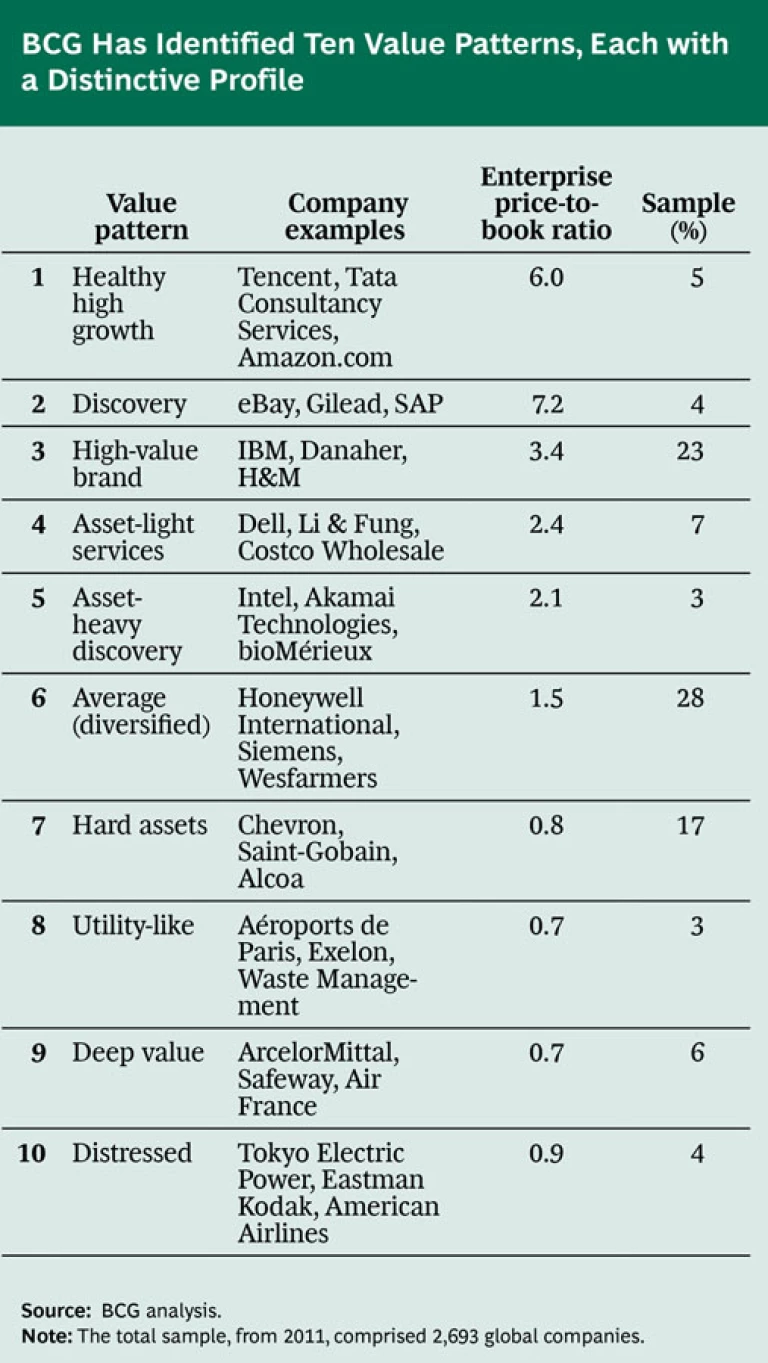The hand you are dealt is determinism; the way you play it is free will.
—Jawaharlal Nehru
Professional poker players rarely talk about “vision” as a path to victory. They focus on how best to play the cards they are dealt. When players are making their bets, the cards themselves are important, but so are other factors: the positions and strategies of the various players, the size of their bets, the amount each player can afford to risk, and even each player’s energy level, mood, and confidence. In other words, a player’s starting position matters; the odds of success for any particular choice depend on the context.
Value Patterns
In this series, BCG Fellow Gerry Hansell explores how value patterns shape the strategic moves most likely to create value.
- The CEO as Investor
- Value Patterns: The Concept
- How Value Patterns Work
A CEO’s strategic and investment choices are also calculated bets, made in a competitive and uncertain environment. Winning strategies create value over time, returning more than a dollar for each dollar invested. The range of potential investments is diverse and dynamic: acquisitions, new plant capacity, share buybacks, innovation investments, expenditures for customer acquisition, a divestiture that exchanges future business results for cash today. As in a poker game, your starting position provides important context when you are choosing how to play your hand.
One of the more challenging aspects of managing a company’s investment choices, however, is to gain an accurate understanding of the appropriate context. Sometimes the players at the table—and even the game itself—change in unexpected ways.
Many executives frame their strategic context primarily in terms of their industry. But as competitive boundaries shift, companies with quite different business models and economics compete to serve similar customer needs. Amazon.com, Wal-Mart, and Best Buy all sell consumer electronics; Juniper Networks, Alcatel-Lucent, and Cisco Systems all compete in telecommunications equipment. And most industries today show a wide range of company starting positions—each with distinctive business economics, types of risks, and opportunities. Consider the different priorities of Southwest and American in air travel, or Target, Sears, and Kohl’s in retailing.
Although starting positions are multidimensional and vary widely across companies and industries, experience and intuition suggest that there are some common types that occur repeatedly in the marketplace. We call them value patterns.
The Idea of a Value Pattern
A value pattern describes how a company’s starting position at a given point in time shapes the range and types of strategic moves that are most likely to create value. Some value patterns are fairly intuitive and easy to grasp. For example, distressed companies (roughly 4 percent of all public companies) have a specific and easy-to-recognize profile. They have high debt levels and severe constraints on liquidity. They often face external headwinds that result in low or negative returns on capital and negative organic-growth rates. They also trade at low valuations—the enterprise value at market is lower than book value—reflecting their high risk and poor reinvestment economics.
At the other end of the spectrum, there is a healthy high-growth value pattern that most people recognize immediately. This pattern (seen in about 5 percent of all public companies) captures the challenges faced by healthy and successful companies that are still relatively young and growing rapidly. These companies have invented something new and are gaining share in the world as they commercialize their innovation. Their business is expected (and also priced by investors) to double sales several times over the next five to ten years.
Some recent examples include companies with a highly scalable digital business model (Facebook and Twitter), with an advantaged retail format that is still in growth mode (athletic-apparel maker Lululemon Athletica and restaurant chain Chipotle Mexican Grill), or, more generally, with a proprietary product or service whose strong momentum has not yet grown fully into its visible potential (Intuitive Surgical, makers of a system for minimally invasive robotic surgery, and Cognizant, an IT consulting and outsourcing provider). Investors, seeing the strong prospects of these companies, value them at high multiples, often in the range of four to eight times enterprise book value.
Ten Common Value Patterns
Most companies fall somewhere between these two extremes. To explore the wider range of value patterns, The Boston Consulting Group has been conducting research that combines input from our client casework, discussions with professional investors and corporate executives, and an empirical review of the performance and valuations of approximately 2,700 large global enterprises. The initial findings of this research are intriguing: we’ve identified ten value patterns within the overall market, each with its own distinctive combination of opportunities, tradeoffs, risks, and relevant strategic moves that are most likely to create value. (See the exhibit “BCG Has Identified Ten Value Patterns, Each with a Distinctive Profile.”)
About three-fourths of all companies have some starting-position “spikiness” that differentiates them from the average company. These value patterns are distinctive, and to an outside observer—such as a professional investor—they suggest clear pathways to competitive success and value creation. About one in four companies, however, has a starting position that we call average (diversified). These companies have characteristics close to the average company in our sample. Instead of being able to focus on two or three clear issues in their investment thesis, they have to take a more balanced approach.
Value patterns share four general characteristics. First, they cut across industry boundaries. Each includes companies from quite different industries. And companies within a single industry may have quite different value patterns. Second, each group’s profile is relatively stable over time—although individual companies sometimes move between groups. Third, capital structure, dividend payout, and other financial policies tend to differ by group. So do the tradeoffs between growth and margins, the pattern of “unlocks” (that is, the major value-creating moves), and the key pitfalls (that is, the ways companies in each group tend to destroy value). Finally, each of the patterns has distinct drivers of valuation multiples, and a few of the groups attract particular types of professional investors who specialize in that value pattern and have distinct screening criteria and metrics of interest.
Implications for Senior Executives
Value patterns do not offer a one-size-fits-all prescription or strategy cookbook. The investment thesis and strategic agenda for any particular company will be highly specific to its particular situation and will reflect critical issues not captured by the outside view of a company’s starting position. In particular, there is an inside view, not fully visible to outsiders, that incorporates management’s view of the company’s proprietary opportunities to create value.
Nevertheless, by identifying the types of actions that are more likely to create value, a company’s value pattern is an essential input that helps inform the strategic agenda. Put another way, knowing your value pattern won’t necessarily tell you what to do, but it will tell you where the better odds are—and where experienced outsiders might expect you to focus.
We believe that a working understanding of value patterns presents senior executives with four key imperatives.
Embrace the outside view. Engage honestly in understanding the realities of your company’s starting position. How would a savvy investor describe it—for each major part of the business and for the company overall? Especially when there is bad news—a negative industry outlook, an underperforming business, or investments not performing as planned—it’s critical to candidly embrace those facts and their consequences.
Frame an investment thesis that fits your value pattern. Every company needs an investment thesis—an agenda that outlines the handful of key actions that are required to drive attractive performance over a specific time horizon (usually three to five years). This thesis is not a summary of broad aspirations (such as targeted growth rates) or a catalog of advantages the company enjoys (such as leading brands). Rather, the investment thesis describes the short list of specific actions that, if successful, will create value. Management’s ambition is an important input to that agenda, but ambition alone is dangerous. A good thesis guides and shapes ambition by incorporating the specific tradeoffs, risks, and pressure points of the company’s starting position.
Test your investment thesis for new unlocks. For every value pattern, there is a small set of specific and critical leverage points that have the potential to unlock large amounts of value. Leading category innovation, fixing a troubled business, simplifying the portfolio, paying down debt, returning more cash to investors, improving asset productivity, and other moves might be among the key moves that drive success. But which levers really matter depends on the value pattern.
Anticipate shifts from one value pattern to another. Over time, businesses change, and their competitive environment shifts, sometimes abruptly. These changes trigger different business economics and investor expectations, causing a transition from one value pattern to another.
One of the biggest challenges facing executive teams is being able to recognize the significance of such shifts and respond quickly and appropriately. In many cases, these marketplace shifts require changing deeply held assumptions, which can be especially difficult for a team that is strongly committed to its current strategy. A knowledge of value patterns and their dynamics can provide a rapid “second opinion” on performance priorities as new events unfold.
A New Lens
Leadership’s challenge is to develop an attractive investment thesis—one that fits the context—and then to drive successful execution against that thesis. What are the right bets to pursue, and how will the company make them pay off? In a fast-changing world, value patterns offer a fresh lens for aligning corporate priorities with the moves that will create advantage and value.






